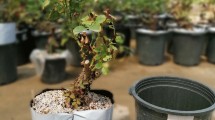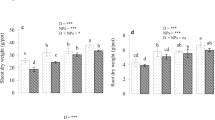Abstract
Deficit irrigation affected drastically growth kinetics and leaves traits with variant degrees drawing the tolerance or sensitivity of four wheat cultivars which recorded from pre- to post-anthesis stage. The main susceptibility characters of hypersensitive cultivar Sohag 3 were reduction of photosynthetic efficiency (chlorophyll and photosynthetic rate), leaf greenness (low leaf area index; LAI), accelerated leaf aging (low biomass duration; BMD and leaf area duration; LAD), thinner and lighter leaves (high specific leaf area; SLA and high leaf area ratio; LAR) which dramatically reflected on low net assimilation rate; NAR and unit leaf rate; ULR, hence diminished absolute growth rate; AGR and relative growth rate; RGR, the vice versa was displayed by the most tolerant cultivar Seds 12. Intermediated response was manifested by cultivars Benisuif 5 and Sakha 93, since the former was close in response to cultivar Seds 12 and the latter showed the main characters of cultivar Sohag 3 but in lower degree. The photo-catalytic property of TiO2-NPs seemingly accomplished improvement of leaves and growth kinetics traits by fertigation the soil of wheat cultivars growing at different water regimes. TiO2-NPs fertigation promoted leaf characteristics through production of thicker and heavier leaves as well as promoting leaf longevity by enhancement of BMD and LAD. Thus, TiO2-NPs activated production of vigor and well-constructed leaves with higher chlorophyll and photosynthetic rate thereby, high LAI, hence higher values of RGR, AGR, ULR and NAR.






Similar content being viewed by others
Abbreviations
- AGR:
-
Absolute growth rate
- BMD:
-
Biomass duration
- cv:
-
Cultivar
- LAD:
-
Leaf area duration
- LAI:
-
Leaf area index
- LAR:
-
Leaf area ratio
- NAR:
-
Net assimilation rate
- Pn :
-
Photosynthetic rate
- RGR:
-
Relative growth rate
- SLA:
-
Specific leaf area
- TiO2-NPs:
-
Titanium dioxide nanoparticles
- ULR:
-
Unit leaf rate
References
Ahmed, M., Hassan, F., & Asif, M. (2014). Amelioration of drought in sorghum (Sorghum bicolor L.) by silicon. Communications in Soil Science and Plant Analysis, 45, 470–486.
Allahverdiyev, T. I., Talai J. M., Huseynova, I. M., & Aliyev, J. A. (2015). Effect of drought stress on some physiological parameters, yield, yield components of durum (Triticum durum desf.) and bread (Triticum aestivum L.) wheat genotypes. Ekin Journal of Crop Breeding and Genetics, 1(1), 50–62.
Bayuelo-Jiménez, J. S., Debouck, D. G., & Lynch, J. (2003). Growth, gas exchange, water relations, and in composition of Phaseolus species grown under saline conditions. Field Crops Research, 80, 207–222.
Benincasa, M. M. P. (1988). Análise de crescimento de plantas (noções básicas) (p. 41). Jaboticabal: FUNEP.
Benincasa, M. M. P. (2003). Análise de crescimento de plantas (noções básicas) (2nd ed., p. 41). Jaboticabal: FUNEP.
Craufurd, P. Q., Wheeler, T. R., Ellis, R. H., Summerfield, R. J., & Williams, J. H. (1999). Effect of temperature and water deficit on water-use efficiency, carbon isotope discrimination, and specific leaf area in peanut. Crop Science, 39, 136–142.
Dionisio-Sese, M. L., & Tobita, S. (1998). Antioxidant responses of rice seedlings to salinity stress. Plant Science, 135, 1–9.
Ehdaie, B., Alloush, G. A., Madore, M. A., & Waines, J. G. (2006). Genotypic variation for stem reserves and mobilization in wheat: II. Post-anthesis changes in internode water-soluble carbohydrates. Crop Science, 46, 2093–2103.
Evans, G. C. (1972). The quantitative analysis of plant growth. Black Well, Oxford. ISBN 0-632-06130-8.
Fageria, N. K., Baligar, V. C., & Clark, R. B. (2006). Physiology of crop production. New York: The Haworth Press.
Feizi, H., Rezvani Moghaddam, P., Shahtahmassebi, N., & Fotovat, A. (2012). Impact of bulk and nanosized titanium dioxide (TiO2) on wheat seed germination and seedling growth. Biological Trace Element Research, 146, 101–106.
Garnier, E., Shipley, B., Roumet, C., & Laurent, G. (2001). A standardized protocol for the determination of specific leaf area and leaf dry matter content. Functional Ecology, 15, 688–695.
Gogos, A., Knauer, K., & Bucheli, T. D. (2012). Nanomaterials in plant protection and fertilization: Current state, foreseen applications, and research priorities. Journal of Agricultural and Food Chemistry, 60, 9781–9792.
Hong, F., Yang, F., Liu, C., Gao, Q., Wan, Z., Gu, F., et al. (2005). Influence of nano-TiO2 on the chloroplast aging of spinach under light. Journal of the American Society for Horticultural Science, 104, 249–260.
Hunt, R. (1990). Basic growth analysis for beginners. London: Academic press.
Jones, M. B., Leafe, E. L., & Stile, W. (1980). Water stress in field grown perennial ryegrass, its effect on growth, canopy photosynthesis and transpiration. Annals of Applied Biology, 2, 87–101.
Khalil, S. K., Hilaire, R. S. T., Khan, A., Rehman, A., & Mexal, J. G. (2011). Growth and physiology of yarrow species Achillea millefolium cv. Cerise Queen and Achillea filipendulina cv. Parker Gold at optimum and limited moisture. Australian Journal of Crop Science, 5, 1698–1706.
Khanghah, A. M., & Jafari, M. A. (2012). A study on various cultivation densities effects on wheat growth indices. International Journal of Agriculture and Crop Sciences, 4, 1337–1341.
Koryo, H. W. (2006). Effect of salinity on growth, physiology, water relations and solute composition of the potential cash crop halophyte Plantago coronopus L. Environmental and Experimental Botany, 56, 136–146.
Kumar, R. A., Singh, M. P., & Kumar, S. A. N. (2012). Growth analysis of wheat (Triticum aestivum L.) genotypes under saline condition. International Journal of Scientific & Technology Research, 1, 15–18.
Lei, Z., Mingyu, S., Chao, L., Liang, C., Hao, H., Xiao, W., et al. (2007). Effects of nanoanatase TiO2 on photosynthesis of spinach chloroplasts under different light illumination. Biological Trace Element Research, 119, 68–76.
Lichtenthaler, H. K. (1987). Chlorophylls and carotenoids: Pigments of photosynthetic biomembranes. Methods Enzymology, 148, 350–382.
Lopez, F. B., Chauhan, Y. S., & Johansen, C. (1997). Effects of timing of drought stress on leaf area development and canopy light interception of short-duration pigeon pea. Journal of Agronomy and Crop Science, 178, 1–7.
Mahmoodzadeh, H., Aghili, R., & Nabavi, M. (2013). Physiological effects of TiO2 nanoparticles on wheat (Triticum aestivum). Journal of Applied Science, Engineering and Technology, 3, 1365–1370.
Mccree, K. J., & Davis, S. D. (1974). Effect of water stress and temperature on leaf epidermal cells in grain sorghum. Crop Science, 5, 751–755.
Mediavilla, S., Escudero, A., & Heilmeier, H. (2001). Internal leaf anatomy and photosynthetic resource-use efficiency: Interspecific and intraspecific comparison. Tree Physiology, 21, 251–259.
Merino, J., Field, C., & Mooney, H. A. (1984). Construction and maintenance costs of Mediterranean-climate evergreen and deciduous leaves. II. Biochemical Pathway Analysis. Acta Oecol/Oecol Plant, 5, 211–229.
Mishra, Vani, Mishra, Rohit K., Dikshit, Anupam, & Pandey, Avinash C. (2014). Interactions of nanoparticles with plants: An emerging prospective in the agriculture industry. Emerging Technologies and Management of Crop Stress Tolerance, 1, 159–180.
Monica, R. C., & Cremonini, R. (2009). Nanoparticles and higher plants. Caryologia, 62, 161–165.
Morteza, E., Moaveni, P., Farahani, H. A., & Kiyani, M. (2013). Study of photosynthetic pigments changes of maize (Zea mays L.) under nano TiO2 spraying at various growth stages. SpringerPlus, 2, 247.
Niinemets, U. (1999). Components of leaf dry mass per area, thickness and density, alter leaf photosynthetic capacity in reverse directions in woody plants. New Phytologist, 144, 35–47.
Norman, J. M., & Campbell, G. S. (1989). Canopy Structure. In R. W. Pearcy, J. Ehleringer, H. A. Mooney, & P. W. Rundel (Eds.), Plant Physiological Ecology: Field methods and instrumentation (pp. 301–325). New York: Chapman & Hall.
Oestigaard, T. (2010). Nile issues, small streams from the Nile basin research programme. Fountain Publishers, Kampala Fountain Publishers. P. O. Box 488, Kampala–Uganda. ISBN 978-9970-25-002-8.
Poorter, H. (1989). Interspecific variation in relative growth rate: On ecological causes and physiological consequences. In H. Lambers, M. L. Cambridge, H. Konings, & T. L. Pons (Eds.), Causes and consequences of variation in growth rate and productivity of higher plants (pp. 45–68). The Hague: SPB Academic Publishing.
Power, J. F., Mills, W. O., & Grunes, D. L. (1967). Effect of soil temperature, phosphorous on growth analysis of barley. Agronomy Journal, 59, 231–234.
Reddy, T. Y., Reddy, V. R., & Anbumozhi, V. (2003). Physiological responses of groundnut (Arachis hypogea L.) to drought stress and its amelioration: A critical review. Plant Growth Regulation, 41, 75–88.
Regan, K. L., Siddique, K. H. M., Turner, N. C., & Whan, B. R. (1992). Potential for increasing early vigor and total biomass in spring wheat. II. Characteristics associated with early vigour. Australian Journal of Agricultural Research, 43, 541–553.
Royo, C., Abaza, M., Blanco, R., & del Moral, L. F. G. (2000). Triticale grain growth and morphometry as affected by drought stress, late sowing and simulated drought stress. Australian Journal of Plant Physiology, 27, 1051–1059.
Schwab, F., Zhai, G., Kern, M., Turner, A., Schnoor, J. L., & Wiesner, M. R. (2016). Barriers, pathways and processes for uptake, translocation and accumulation of nanomaterials in plants–Critical review. Nanotoxicology, 10, 257–278.
Šesták, Z., Čatský, J., & Jarvis, P. G. (Eds.). (1971). Plant photosynthetic production (p. 818). The Hague: Manual of methods.
Talebifar, M., Taghizadeh, R., & Kamali-Kivee, S. I. (2013). Evaluation of growth physiological indices under irrigation stress conditions in different varieties of wheat (Triticum aestivum & durum). International Journal of Agronomy and Plant Production, 4, 507–514.
Tedeschi, A., Riccardia, M., & Menenti, M. (2011). Melon crops (Cucumis melo L., cv. Tendral) grow in a Mediterranean environment under saline–sodic conditions: Part II. Growth Analysis Agricultural Water Management, 98, 1339–1348.
Woolhouse, H. W. (1984). The biochemistry and regulation of senescence in chloroplasts. Canadian Journal of Botany, 62, 2934–2942.
Yang, F., Hong, F., You, W., Liu, C., Gao, F., Wu, C., et al. (2006). Influence of nanoanatase TiO2 on the nitrogen metabolism of growing spinach. Biological Trace Element Research, 110, 179–190.
Zhang, X. Z. (1989). Investigation methods for crop, physiology agric (p. 259). Beijing: Press of China.
Zheng, L., Hong, F., Lu, S., & Liu, C. (2005). Effect of nano TiO2 on strength of naturally aged seeds and growth of spinach. Biological Trace Element Research, 104, 83–91.
Author information
Authors and Affiliations
Corresponding author
Ethics declarations
Conflict of interest
The authors declare that there is no conflict of interest between them for publishing this paper.
Additional information
Publisher's Note
Springer Nature remains neutral with regard to jurisdictional claims in published maps and institutional affiliations.
Rights and permissions
About this article
Cite this article
Dawood, M.F.A., Abeed, A.H.A. & Aldaby, E.E.S. Titanium dioxide nanoparticles model growth kinetic traits of some wheat cultivars under different water regimes. Plant Physiol. Rep. 24, 129–140 (2019). https://doi.org/10.1007/s40502-019-0437-5
Received:
Accepted:
Published:
Issue Date:
DOI: https://doi.org/10.1007/s40502-019-0437-5




